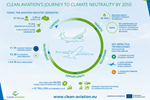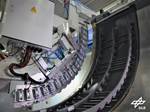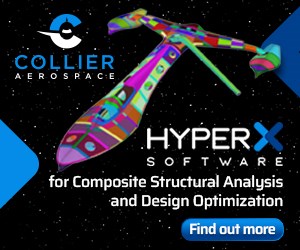Composite INTELLICONT Smart Container advances lean aircraft operation processes
Lightweight, structurally robust unit load device (ULD) with autonomous unloading functions reaches TRL 6 with a 40% weight reduction.

Smart Container loading procedure demonstration. Photo Credit: INTELLICONT consortium
The INTELLICONT (Development and Manufacturing of Intelligent Lightweight Composite Aircraft Container) project under the Clean Sky 2 program, which was completed between March 2018 and February 2021, sought to make a lightweight and structurally robust composite unit load device (ULD) used in air cargo, of which an estimated one million ULDs operate in a majority of global airports.
Conventional ULDs are primarily aluminum cage structures with minimal structural properties and substantial tar weight which the project consortia says penalizes net loading capacity and fuel burn. They also rely on permanent transportation components and crew intervention to be moved and secured in the cargo deck, which further increases aircraft weight, loading time and operating costs. Composites were considered, however, to enable a cargo container that remained resistant to fire and operational loads, in addition to integrating various innovative functions including autonomous unloading and unlocking while maintaining backwards compatibility. Pultrusion and resin transfer molding (RTM) were also considered for low-cost , high-output manufacturing. The INTELLICONT Smart Container reached technology readiness level (TRL) 6 and achieved a weight reduction of approximately 40%.
In the context of the project, an autonomous robotic platform (RP) was developed. The robotic platform and the lower part of the ULD share all the necessary active systems for autonomous connection between them (RP and ULD restraint system), ULD transport to the desired position (RP drive system, RP power system, RP navigation system) and unlocking to the desired load position at the cargo bay (ULD docking system). After completing its task, the RP leaves the aircraft and remains at the airport. In case of power loss, the ULD can be manually unloaded and unlocked with minimum effort from the operator. The design of both ULD and robotic platform enables backwards compatibility and for removal of permanent aircraft cargo components.
In addition, wireless communication and advanced low-cost sensory capabilities were added to the new design. The ULD sends the following information to the cockpit: Self ID, position in the cargo bay, lock status and detection of fire/smoke alarm through a human machine interface (HMI). Additional sensing capabilities include internal temperature and shock/impact monitoring.
The next steps for the technology are to make the Smart Container available to the market and industry. The route towards industrialization and certification has been planned. Although the project prototype was delivered and demonstrated at TRL 6, the project consortia notes that further steps need to be taken. Currently, all partners have analyzed the testing results (preliminary, intermediate and final) and have compiled a roadmap from design to commercialization, including a series of improvements and points of further research interest.
The INTELLICONT consortium included Avionics Greece SA (Spata, Greece); the University of Patras (Greece); Prisma Electronics SA (Alexandroupoli, Greece), Manchester University (U.K.), Acciona Construccion SA (Municipality of Alcobendas, Spain) and the National Technical University of Athens (Athens, Greece). The topic manager was Airbus (Toulouse, France).
The project received funding under the European Union’s H2020-EU.3.4.5.1.-IADP Large Passenger Aircraft, Research and Innovation Programme.
Related Content
-
Plant tour: Spirit AeroSystems, Belfast, Northern Ireland, U.K.
Purpose-built facility employs resin transfer infusion (RTI) and assembly technology to manufacture today’s composite A220 wings, and prepares for future new programs and production ramp-ups.
-
Infinite Composites: Type V tanks for space, hydrogen, automotive and more
After a decade of proving its linerless, weight-saving composite tanks with NASA and more than 30 aerospace companies, this CryoSphere pioneer is scaling for growth in commercial space and sustainable transportation on Earth.
-
Plant tour: Middle River Aerostructure Systems, Baltimore, Md., U.S.
The historic Martin Aircraft factory is advancing digitized automation for more sustainable production of composite aerostructures.
















